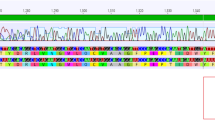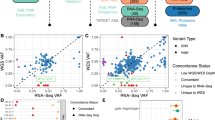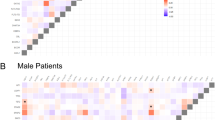Abstract
According to a two hit model of leukaemogenesis, the association between acute myeloid leukaemia (AML)1 mutations and FLT3 gene alterations has been recently described in M0 AML. To further document this model in M0 AML, we screened a cohort of 45 patients to find an association between genes implicated in myeloid differentiation (AML1, Pu1) and genes contributing to cell proliferation: (FLT3, N-RAS, K-RAS, c-KIT, PTPN11). No mutation of the Pu1 gene was observed, whereas mutation in the Runt domain of AML1 gene was observed in 12 of 45 patients (27%). No point mutation or insertion–deletion in the c-kit gene was found. Three point mutations (7%) and 11 internal tandem duplications (22%) were seen in FLT3 gene. Two N-Ras and one PTPN11 mutations were found. No significant correlation between AML1 mutation and FLT3 alteration was found. On the other hand, abnormal cytogenetic findings, especially unfavourable ones, were significantly more frequent in patients without detectable molecular abnormality. These findings suggest at least two different pathogenetic pathways in M0 AML: one associated with AML1 mutation, sometimes in combination with the activating lesion of the tyrosine kinase pathway and generally with normal karyotype, and the other with unfavourable cytogenetic findings.
This is a preview of subscription content, access via your institution
Access options
Subscribe to this journal
Receive 12 print issues and online access
$259.00 per year
only $21.58 per issue
Buy this article
- Purchase on SpringerLink
- Instant access to full article PDF
Prices may be subject to local taxes which are calculated during checkout
Similar content being viewed by others
References
Dash A, Gilliland DG . Molecular genetics of acute myeloid leukaemia. Best Pract Res Clin Haematol 2001; 14: 49–64.
Reya T, Morrison SJ, Clarke MF, Weissman IL . Stem cells, cancer, and cancer stem cells. Nature 2001; 414: 105–111.
Lee EJ, Pollak A, Leavitt RD, Testa JR, Schiffer CA . Minimally differentiated acute nonlymphocytic leukemia: a distinct entity. Blood 1987; 70: 1400–1406.
Matsuno N, Osato M, Yamashita N, Yanagida M, Nanri T, Fukushima T et al. Dual mutations in the AML1 and FLT3 genes are associated with leukemogenesis in acute myeloblastic leukemia of the M0 subtype. Leukemia 2003; 17: 2492–2499.
Lutterbach B, Hiebert SW . Role of the transcription factor AML-1 in acute leukemia and hematopoietic differentiation. Gene 2000; 245: 223–235.
Preudhomme C, Warot-Loze D, Roumier C, Grardel-Duflos N, Garand R, Lai JL et al. High incidence of biallelic point mutations in the Runt domain of the AML1/PEBP2 alpha B gene in Mo acute myeloid leukemia and in myeloid malignancies with acquired trisomy 21. Blood 2000; 96: 2862–2869.
Lamandin C, Sagot C, Roumier C, Lepelley P, De Botton S, Cosson A et al. Are PU.1 mutations frequent genetic events in acute myeloid leukemia (AML). Blood 2002; 100: 4680–4681.
Gilliland DG, Griffin JD . The roles of FLT3 in hematopoiesis and leukemia. Blood 2002; 100: 1532–1542.
Bentires-Alj M, Paez JG, David FS, Keilhack H, Halmos B, Naoki K et al. Activating mutations of the noonan syndrome-associated SHP2/PTPN11 gene in human solid tumors and adult acute myelogenous leukemia. Cancer Res 2004; 64: 8816–8820.
Goemans BF, Zwaan C, Miller M, Zimmermann M, Harlow A, Meshinchi S et al. Mutations in KIT and RAS are frequent events in pediatric core-binding factor acute myeloid leukemia. Leukemia 2005; 19: 1536–1542.
Bene MC, Castoldi G, Knapp W, Ludwig WD, Matutes E, Orfao A et al. Proposals for the immunological classification of acute leukemias. European Group for the Immunological Characterization of Leukemias (EGIL). Leukemia 1995; 9: 1783–1786.
Amadori S, Venditti A, Del Poeta G, Stasi R, Buccisano F, Bruno A et al. Minimally differentiated acute myeloid leukemia (AML-M0): a distinct clinico-biologic entity with poor prognosis. Ann Hematol 1996; 72: 208–215.
Roumier C, Eclache V, Imbert M, Davi F, MacIntyre E, Garand R, Groupe Francais de Cytogenetique Hematologique (GFCH); Groupe Francais d'Hematologie Cellulaire (GFHC). M0 AML, clinical and biologic features of the disease, including AML1 gene mutations: a report of 59 cases by the Groupe Francais d'Hematologie Cellulaire (GFHC) and the Groupe Francais de Cytogenetique Hematologique (GFCH). Blood 2003; 101: 1277–1283.
Care RS, Valk PJ, Goodeve AC, Abu-Duhier FM, Geertsma-Kleinekoort WM, Wilson GA et al. Incidence and prognosis of c-KIT and FLT3 mutations in core binding factor (CBF) acute myeloid leukaemias. Br J Haematol 2003; 121: 775–777.
Kiyoi H, Naoe T, Nakano Y, Yokota S, Minami S, Miyawaki S et al. Prognostic implication of FLT3 and N-RAS gene mutations in acute myeloid leukemia. Blood 1999; 93: 3074–3080.
Carnicer MJ, Nomdedeu JF, Lasa A, Estivill C, Brunet S, Aventin A et al. FLT3 mutations are associated with other molecular lesions in AML. Leuk Res 2004; 28: 19–23.
Meshinchi S, Stirewalt DL, Alonzo TA, Zhang Q, Sweetser DA, Woods WG et al. Activating mutations of RTK/ras signal transduction pathway in pediatric acute myeloid leukemia. Blood 2003; 102: 1474–1479. E-pub 2003 Apr 17.
Downing JR . AML1/CBFbeta transcription complex: its role in normal hematopoiesis and leukemia. Leukemia 2001; 15: 664–665.
Roumier C, Fenaux P, Lafage M, Imbert M, Eclache V, Preudhomme C . New mechanisms of AML1 gene alteration in hematological malignancies. Leukemia 2003; 17: 9–16.
Nanri T, Matsuno N, Kawakita T, Suzushima H, Kawano F, Mitsuya H et al. Mutations in the receptor tyrosine kinase pathway are associated with clinical outcome in patients with acute myeloblastic leukemia harboring t(8;21)(q22;q22). Leukemia 2005; 19: 1361–1366.
Tartaglia M, Niemeyer CM, Fragale A, Song X, Buechner J, Jung A et al. Somatic mutations in PTPN11 in juvenile myelomonocytic leukemia, myelodysplastic syndromes and acute myeloid leukemia. Nat Genet 2003; 34: 148–150.
Nakao M, Horiike S, Fukushima-Nakase Y, Nishimura M, Fujita Y, Taniwaki M et al. Novel loss-of-function mutations of the haematopoiesis-related transcription factor, acute myeloid leukaemia 1/runt-related transcription factor 1, detected in acute myeloblastic leukaemia and myelodysplastic syndrome. Br J Haematol 2004; 125: 709–719.
Song WJ, Sullivan MG, Legare RD, Hutchings S, Tan X, Kufrin D et al. Haploinsufficiency of CBFA2 causes familial thrombocytopenia with propensity to develop acute myelogenous leukaemia. Nat Genet 1999; 23: 166–175.
Alcalay M, Meani N, Gelmetti V, Fantozzi A, Fagioli M, Orleth A et al. Acute myeloid leukemia fusion proteins deregulate genes involved in stem cell maintenance and DNA repair. J Clin Invest 2003; 112: 1751–1761.
Acknowledgements
This work was supported by Grants from the Fondation de France, comité Leucémie, Ligue contre le Cancer, Comité du Nord, Canceropole Nord-ouest, Axe onco-hématologie. Authors thank the GFHC for their kind cooperation.
Author information
Authors and Affiliations
Corresponding author
Rights and permissions
About this article
Cite this article
Roumier, C., Lejeune-Dumoulin, S., Renneville, A. et al. Cooperation of activating Ras/rtk signal transduction pathway mutations and inactivating myeloid differentiation gene mutations in M0 AML: a study of 45 patients. Leukemia 20, 433–436 (2006). https://doi.org/10.1038/sj.leu.2404097
Received:
Revised:
Accepted:
Published:
Issue date:
DOI: https://doi.org/10.1038/sj.leu.2404097
Keywords
This article is cited by
-
−7/7q− syndrome in myeloid-lineage hematopoietic malignancies: attempts to understand this complex disease entity
Oncogene (2015)
-
Darbepoetin inhibits proliferation of hepatic cancer cells in the presence of TGF-β
Archives of Toxicology (2014)
-
High levels of the adhesion molecule CD44 on leukemic cells generate acute myeloid leukemia relapse after withdrawal of the initial transforming event
Leukemia (2011)
-
Cooperating gene mutations in acute myeloid leukemia: a review of the literature
Leukemia (2008)



